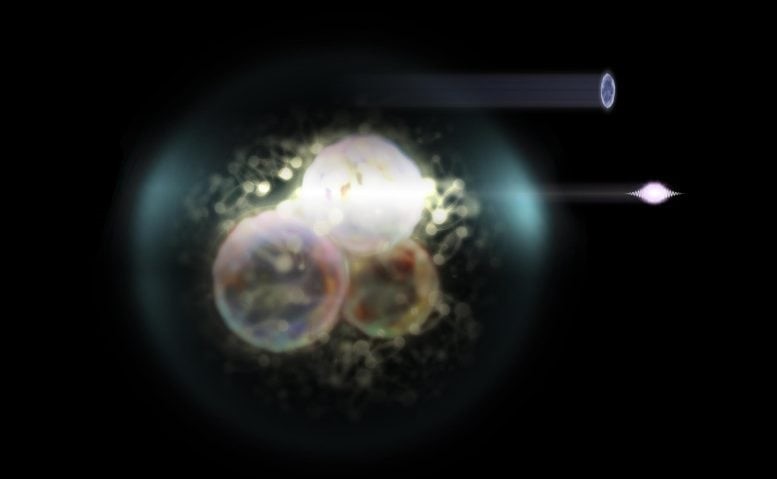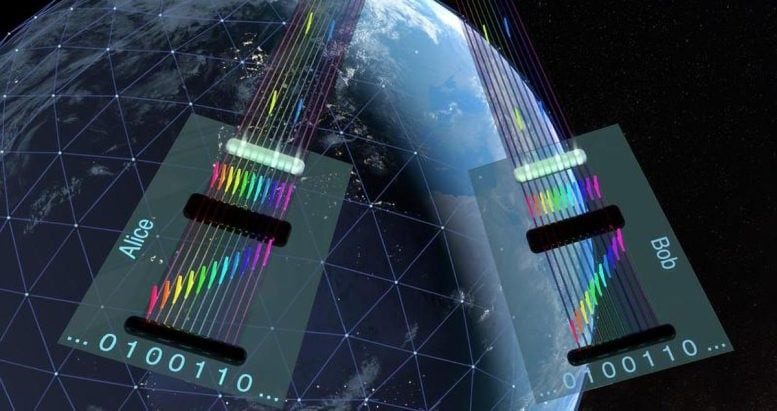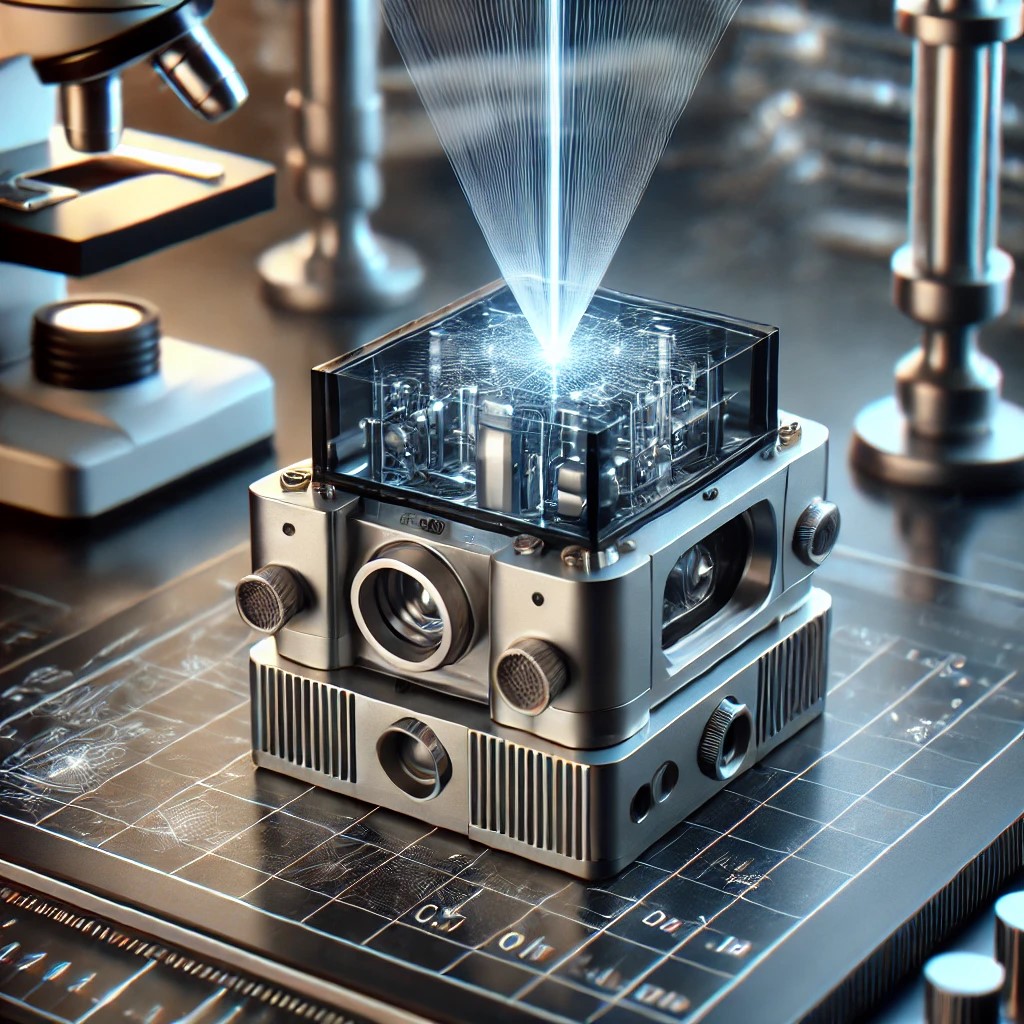Quantum Revolution: Capturing Atoms on a Microchip
By integrating photonics to miniaturize cold atom trapping, researchers are advancing portable quantum technologies.Their photonic chip system substitutes traditional free-space optics, paving the way for highly precise and deployable quantum sensors and computing devices.
Miniaturizing Quantum Experiments on a Chip
Researchers at UC Santa Barbara are striving to condense cold atom quantum experiments from bulky laboratory setups to compact, chip-based systems. This breakthrough has the potential to transform areas such as precision sensing, timekeeping, quantum computing, and fundamental science."We're on the verge of a major shift," said Daniel Blumenthal, a professor of electrical and computer engineering.

Figure 1. Photonic System with Chip-Scale Optics.
Harnessing the Potential of Cold Atoms
In a featured article for Optica Quantum, Professor Daniel Blumenthal, along with graduate student Andrei Isichenko and postdoctoral researcher Nitesh Chauhan, showcase recent advancements and future prospects in atom trapping and cooling. Their research focuses on miniaturizing these powerful quantum technologies to develop portable devices, potentially small enough to fit in the palm of a hand. Figure 1 photonic system with chip-scale optics.
Cold atoms are cooled to temperatures below 1 millikelvin, drastically slowing their motion and allowing quantum effects to dominate. This extreme sensitivity makes them ideal for detecting faint electromagnetic signals, probing fundamental particles, enabling ultra-precise timekeeping, navigation, and serving as "qubits" for quantum computing applications.
Overcoming the Challenges of Miniaturization
To harness the unique properties of cold atoms, researchers typically rely on highly sensitive, laboratory-scale optical systems to trap, confine, and cool the atoms. These conventional setups use free-space lasers and optics, where beams are manipulated through lenses, mirrors, and modulators, combined with magnetic coils and vacuum chambers to create cold atoms using a standard three-dimensional magneto-optical trap (3D-MOT).
The major challenge lies in miniaturizing these complex optical and magnetic systems onto a compact, robust device capable of functioning outside the controlled lab environment [1]. Developing such a portable platform would enable groundbreaking applications in gravitational sensing, precision timekeeping, metrology, and quantum computing.
Advancing Photonic Integration: A Major Breakthrough
The Optica Quantum review article highlights significant and rapid progress in miniaturizing complex cold-atom experiments through the use of compact optics and integrated photonics. The authors draw parallels between breakthroughs in photonics across various fields — including telecommunications and sensing — and their potential application in cold atom science, aiming to bridge the gap between large-scale laboratory systems and portable quantum devices.
"We successfully created cold atoms using integrated photonics for the first time," the authors noted, marking a critical milestone in advancing compact and deployable quantum technologies.
“There has been significant progress in miniaturizing beam delivery,” said Isichenko, “but most of it still relies on free-space optics — such as smaller mirrors or gratings — without achieving full integration of functionalities onto a single chip.”
This challenge led the researchers to develop a photonic integrated 3D-MOT (PICMOT), a compact version of the traditional setup used to generate and deliver laser beams for cooling and trapping atoms. Built on a low-loss silicon nitride waveguide platform, the PICMOT performs all the essential functions — generating, routing, expanding, and manipulating light beams — within a fully integrated photonic system.
The Optica Quantum review article recognizes the PICMOT developed by the UC Santa Barbara team as a major breakthrough in the field of cold atom science.“With photonic integration, we can now place lasers, modulators, and large-area grating emitters directly on the chip,” Isichenko explained. “This enables us to efficiently direct light on and off the chip, fundamentally transforming cold atom experiments.”
Achieving Precision in Atom Trapping
A key component of the system is the atomic cell — a vacuum chamber where atoms are trapped and cooled. One of the team's major achievements was successfully routing input light from an optical fiber, thinner than a strand of hair, through waveguides to three grating emitters. These emitters produce three collimated, free-space intersecting beams, each 3.5 mm wide. By reflecting each beam back on itself, the setup forms six intersecting beams capable of trapping up to a million atoms from the vapor inside the cell. Combined with magnetic fields, the atoms are cooled to an ultra-low temperature of just 250 microkelvin (uK).
According to Blumenthal, increasing the beam size allows more atoms to be trapped and interrogated, ultimately enhancing the precision of the instrument. This high-precision trapping marks a significant step toward developing compact quantum devices.
“For the first time, we’ve successfully created cold atoms using integrated photonics,” said Blumenthal, emphasizing the breakthrough.
Broadening the Impact of Quantum Technology
The impact of the researchers' innovations extends far beyond the laboratory. With ongoing advancements in durability and functionality, future chip-scale MOT (Magneto-Optical Trap) designs could integrate a wide range of photonic components, including recently demonstrated chip-scale lasers [2]. This would optimize the technology for diverse applications such as monitoring volcanic activity, measuring sea level rise, and tracking glacier movements by detecting subtle changes in Earth's gravitational gradient.
The integration of the 3D-MOT opens new frontiers for quantum science and precision timekeeping, potentially enabling the deployment of current ground-based instruments into space for groundbreaking fundamental research. Such devices could perform measurements that are impossible to achieve on Earth, providing new insights into gravity, time, and quantum phenomena.
Moreover, these compact and integrated systems could streamline research processes by reducing the time and complexity involved in setting up and calibrating optical systems. This advancement could also make quantum research more accessible, empowering future generations of physicists to explore quantum science with portable and cost-effective tools.
Reference:
- https://scitechdaily.com/quantum-revolution-atoms-trapped-on-a-chip/
- https://www.forbes.com/sites/moorinsights/2021/09/14/ionq-delivers-a-new-architecture-and-glass-quantum-computer-chip-a-year-earlier-than-expected/
Cite this article:
Keerthana S (2025),Quantum Revolution: Capturing Atoms on a Microchip, AnaTechMaz, pp. 210















